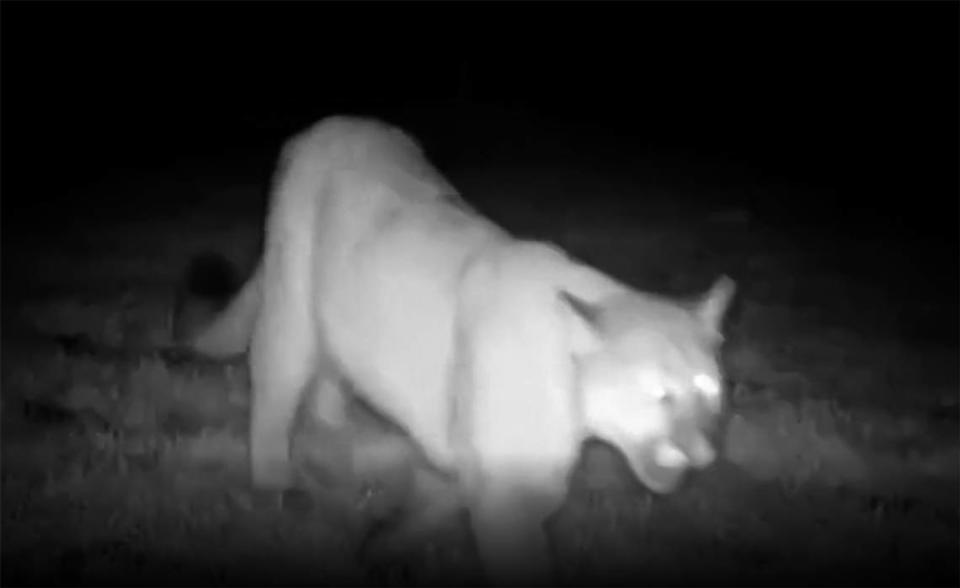Spring cougar sighting near Tri-Cities. Rural Benton County resident catches it on video
A check of a trail cam just west of Benton City turned up a surprise for the camera’s owner.
About 9:30 p.m. Monday, April 10, a cougar strolled past the camera that Joseph McCollum had placed in an easement by his house and an agricultural area.
In the six to eight months he’s had the camera there it has captured images of coyotes, rabbits, skunks and raccoons. But this was the only cougar McCollum has seen so far.
Last spring, several cougars were spotted near Tri-Cities area homes between late March to May.
One was shot in a Finley orchard in March 2022. Then a cougar was caught on camera loping down a West Pasco sidewalk. In May 2022 a cougar was spotted near Zintel Canyon in Kennewick.
Construction workers also reported a cougar in south Kennewick in April 2022 in a new subdivision, but did not get it on camera.
McCollum said he’s heard stories about cougars in the neighborhood where he lives and has assumed they were out there “but we’ve never seen one before,” he said.
His family has young children and a miniature dachshund and have taken precautions since they moved to their home three years ago to keep them safe there because of the many coyotes in the area.

Mountain lions spotted in parts of the Tri-Cities area where people live or work likely are passing through, rather than animals who live long-term nearby, said Jason Fidorra, a Washington state Department of Fish and Wildlife biologist for Benton and Franklin counties, last spring.
There are some that live in the wildland habitat of the Columbia Basin surrounding the Tri-Cities, just not many, he said. Most cougars in Washington state live in forested areas.
Young males may mature and be ready to disperse to find their own territories and seek a potential mate in the spring. However, that’s not the only time of year they may pass through since cougars can breed throughout the year.
There have long been cougars moving through the area, perhaps finding cover along its rivers, Fidorra said. Rivers are easy for cougars to follow as they disperse over long distances.
McCollum lives west of Whan Drive and Old Inland Empire Highway, which is near the Yakima River.
In almost all cases cougars are looking to avoid contact with humans, Fidorra said.
Cougar attacks on humans are extremely rare, according to the Washington state cougar information website. It lists two fatal cougar attacks on humans, one in 1924 and another in 2018. Since 1924, 19 other human encounters with cougars left a person injured.
There are steps people can take to help make sure they are not among the very few who meet a mountain lion in the Tri-Cities area, particularly if they live in outlying areas.
The Washington state Department of Fish and Wildlife recommends securing garbage and not leaving out pet food or other food that could draw in wildlife. Garbage and pet food can attract small mammals that, in turn, attract cougars.
Bring pets inside at night to prevent them from being prey to a cougar or coyote, and be aware that cougars may prey on small farm animals, including goats and chicken.
If you meet a cougar
Few people will ever catch a glimpse of a cougar, much less confront one.
If you do come face to face with a cougar, here’s what state wildlife officials say you should know:
▪ Pick up small children and pets. but don’t run. At close range, a cougar’s instinct is to chase.
▪ Face the cougar and talk to it firmly as you slowly back away. Leave the animal an escape route.
▪ Try to look larger than the cougar. Hold your jacket open to look larger and stand shoulder-to-shoulder with anyone you may be with.
▪ Don’t take your eyes off the cougar or turn your back. Do not try to hide.
▪ If the cougar does not flee or shows signs of aggression — crouching with ears back, teeth bared, hissing, tail twitching and hind feet pumping in preparation to jump — wave your arms and throw anything you have, like a water bottle, at the animal.
▪ If the cougar attacks, fight back and try to stay on your feet. Cougars have been driven away by people who fought back using sticks, rocks, shovels backpacks, clothing and even their bare hands. If you are aggressive enough the cougar will realize it has made a mistake and flee.

